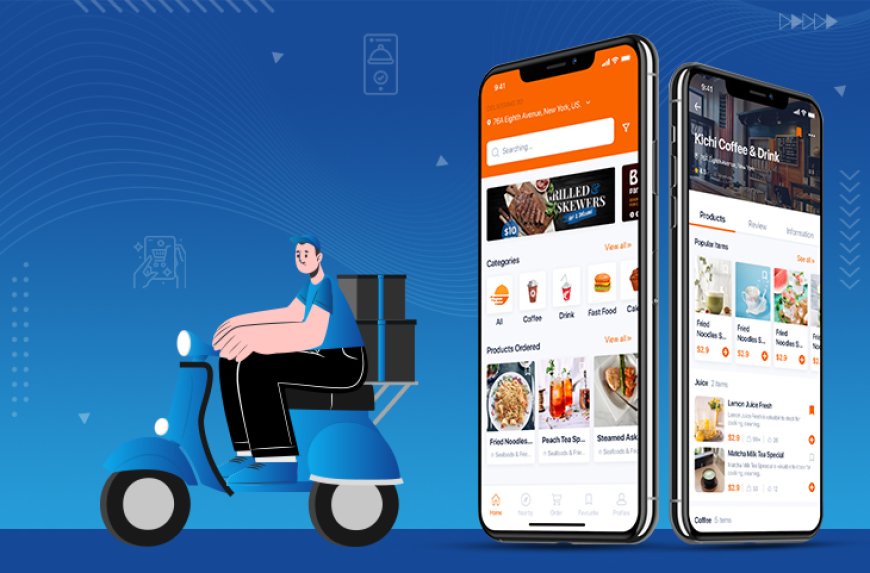How Can You Create a Cutting-Edge Food Delivery App?

Creating a cutting-edge food delivery app involves a series of well-planned steps, from ideation to deployment. To build an app that stands out in a crowded market, you must focus on user experience, innovative features, and seamless performance. Partnering with a reputable food delivery app development company can streamline this process and ensure the highest quality results. Here’s a detailed guide to help you create a state-of-the-art food delivery app.
1. Understanding the Market
-
Market Research
Before diving into development, conduct thorough market research. Identify the current trends, competitors, and target audience preferences. Analyze successful apps to understand what works and what doesn’t.
-
Identifying the Target Audience
Determine who your potential users are. Are they college students, working professionals, families, or a mix of different demographics? Understanding your audience will help you tailor your app’s features and design.
-
Competitor Analysis
Study your competitors to identify their strengths and weaknesses. Look at user reviews to find gaps in the market that your app can fill.
2. Defining the Features
Essential Features
-
User Registration and Profile Management: This allows users to create accounts and manage their profiles easily.
-
Restaurant Listings: Provide a comprehensive list of restaurants with detailed information, including menus, prices, and ratings.
-
Search and Filter Options: Enable users to search for specific cuisines, dishes, or restaurants, and apply filters based on price, distance, ratings, etc.
-
Order Placement and Tracking: Simplify the ordering process and provide real-time tracking of deliveries.
-
Payment Integration: Offer multiple payment options, including credit/debit cards, digital wallets, and COD (Cash on Delivery).
-
Notifications and Alerts: Keep users informed about their order status, special offers, and updates through push notifications.
-
Reviews and Ratings: Allow users to rate and review restaurants and delivery services.
Advanced Features
-
AI-Powered Recommendations: Use artificial intelligence to suggest restaurants and dishes based on user preferences and past orders.
-
Chatbots for Customer Support: Implement AI chatbots to handle common queries and provide 24/7 customer support.
-
Loyalty Programs and Rewards: Introduce a rewards system to encourage repeat orders and increase user retention.
-
Multi-Language Support: Cater to a broader audience by offering multiple language options.
-
Voice Search: Enable users to search for restaurants and dishes using voice commands.
-
Augmented Reality (AR) Menus: Provide an interactive menu experience with AR to visualize dishes before ordering.
3. Designing the User Interface (UI)
User-Centric Design
Focus on creating a user-friendly interface that is intuitive and easy to navigate. The design should be aesthetically pleasing and consistent with your brand identity.
Wireframing and Prototyping
Start with wireframes to outline the app’s structure and layout. Move on to creating prototypes to test the user flow and functionality before finalizing the design.
Responsive Design
Ensure your app is responsive and works seamlessly across different devices and screen sizes. Mobile responsiveness is crucial for a food delivery app.
4. Choosing the Right Technology Stack
Frontend Development
-
React Native or Flutter: For cross-platform app development, consider using React Native or Flutter to save time and resources.
-
Swift (iOS) and Kotlin (Android): For native app development, use Swift for iOS and Kotlin for Android to ensure high performance and better user experience.
Backend Development
-
Node.js or Django: Use Node.js or Django for building a robust and scalable backend.
-
Database Management: Opt for databases like MongoDB, PostgreSQL, or Firebase for efficient data management.
-
Cloud Services: Utilize cloud services like AWS, Google Cloud, or Azure for reliable hosting and scalability.
4. Development Process
Agile Methodology
Adopt an agile development approach to allow flexibility and iterative progress. Agile methodology helps in incorporating feedback and making necessary adjustments throughout the development cycle.
MVP Development
Start with a Minimum Viable Product (MVP) that includes the core features. Launch the MVP to gather user feedback and validate your app concept. Use this feedback to refine and expand your app.
Integration of APIs
Integrate essential APIs for functionalities such as payment gateways (Stripe, PayPal), maps (Google Maps), and notifications (Firebase Cloud Messaging).
5. Ensuring Security and Compliance
Data Encryption
Implement data encryption to protect user information during transactions and data storage.
Secure Payment Gateway
Use secure payment gateways that comply with PCI-DSS standards to ensure safe financial transactions.
Privacy Policies and Compliance
Ensure your app complies with data protection regulations like GDPR or CCPA. Clearly outline your privacy policies to gain user trust.
6. Testing and Quality Assurance
Manual and Automated Testing
Conduct thorough testing, both manual and automated, to identify and fix bugs—test for usability, functionality, performance, and security.
Beta Testing
Launch a beta version of your app to a limited audience to gather real-world feedback and identify any issues before the final release.
7. Deployment and Launch
App Store Optimization (ASO)
Optimize your app’s listing on the App Store and Google Play Store. Use relevant keywords, compelling descriptions, and high-quality screenshots to attract downloads.
Marketing and Promotion
Develop a marketing strategy to promote your app. Utilize social media, content marketing, influencer collaborations, and paid ads to reach a wider audience.
8. Post-Launch Maintenance and Updates
User Feedback
Continuously gather and analyze user feedback to improve your app. Address any issues promptly and implement suggested features.
Regular Updates
Regularly update your app to introduce new features, improve performance, and fix bugs. Keep your users engaged with fresh content and functionalities.
Performance Monitoring
Use analytics tools to monitor your app’s performance and user behavior. Identify areas for improvement and optimize accordingly.
Conclusion
Creating a cutting-edge food delivery app requires careful planning, a focus on user experience, and continuous improvement. By following these steps and staying updated with the latest trends and technologies, you can develop an app that not only meets but exceeds user expectations. Remember, the key to success lies in delivering a seamless, enjoyable, and reliable food delivery experience.
What's Your Reaction?

























